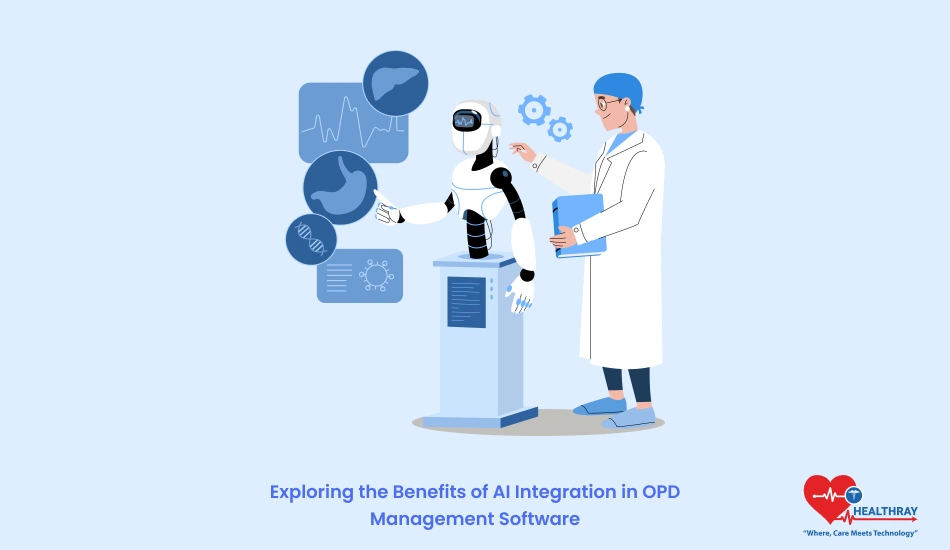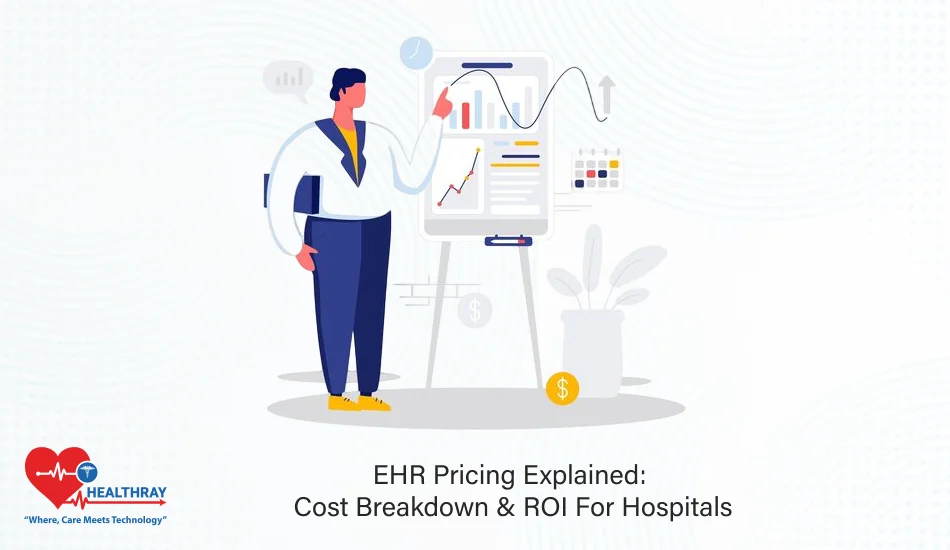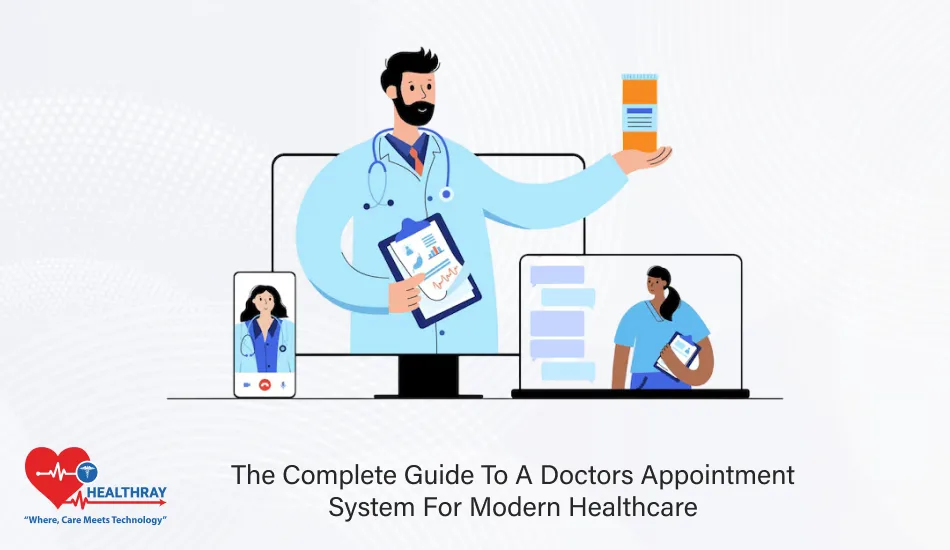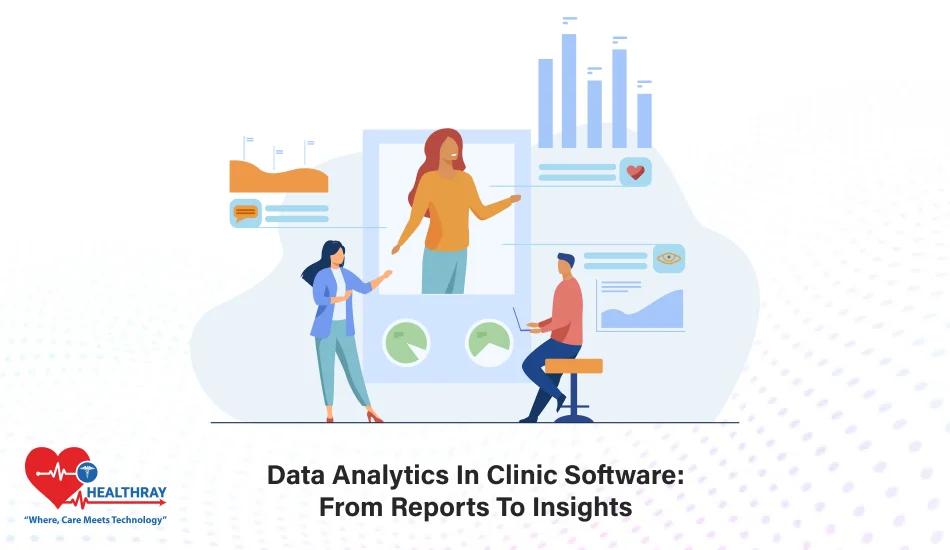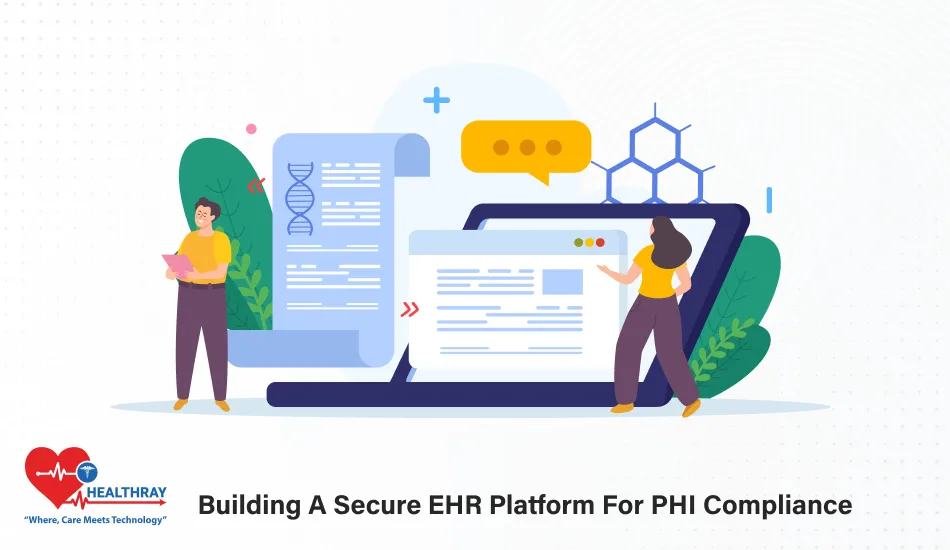Hospital outpatient departments (OPDs) handle a massive influx of patients daily, making operational efficiency a top priority. With long queues, administrative bottlenecks, and ever-growing patient data, the challenge to deliver seamless services continues to rise.
This is where AI-powered OPD hospital management software steps in. Imagine AI systems predicting peak hours, reducing wait times, and automating repetitive tasks like appointment scheduling or billing. These tools don’t just streamline operations; they elevate patient experiences and ease the burden on hospital staff.
Understanding OPD Management Software: The Backbone of Outpatient Care
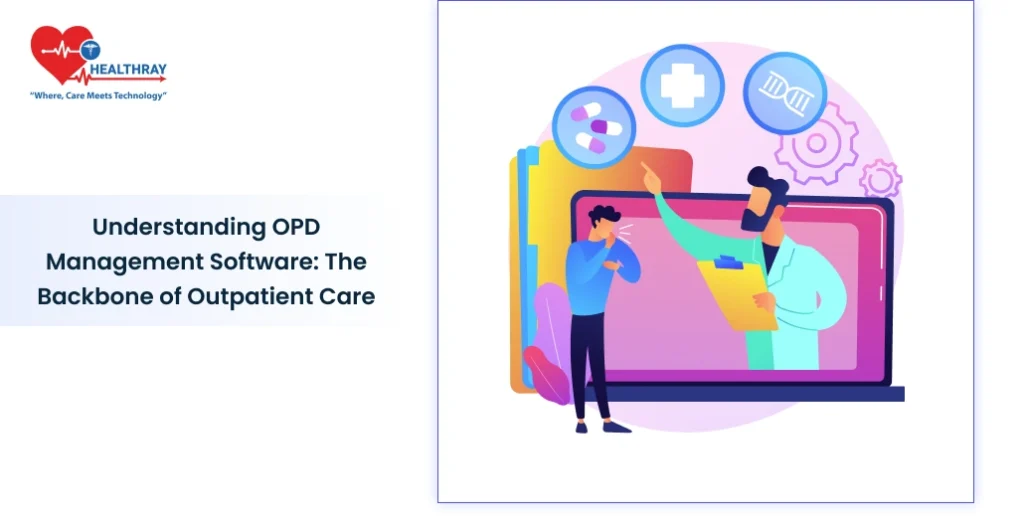
OPD management software serves as the central hub for handling outpatient services in a hospital. It organizes tasks like appointment scheduling, patient record management, billing, and report generation, creating a streamlined experience for both patients and healthcare staff.
Key Features of OPD Management Software
- Appointment Scheduling: Enables quick booking and real-time updates on doctor availability.
- Patient Record Management: Stores medical histories, prescriptions, and test results in a structured format.
- Billing Automation: Simplifies payment processes by generating accurate invoices and tracking transactions.
- Physician management Administer doctor information and their whole day schedule
- Reminders: Streamlines to remind physicians and patients, reducing no-shows.
- Data security: Prevent information from cyber threat or malicious attacks
- Prescription Management: Create prescription templates along with protocols.
- Reporting and Analytics: Provides insights into patient flow, treatment efficiency, and financial performance.
Challenges in Traditional OPD Management
- Manual Errors: Paper-based systems or outdated software often lead to inaccuracies.
- Time-Consuming Processes: Routine tasks like appointment bookings can take hours when handled manually.
- Inefficiency in Data Handling: Sorting through patient files and administrative paperwork can slow down operations.
- Limited Patient Satisfaction: Long waiting times and administrative delays often frustrate patients.
- Collecting cash: Difficult to manage huge amounts of money and precise recording in registers.
- Gather information: Vast information of patients and staff members, difficult to collect and retrieve it.
- Compliance issues: A major issue and costs arising when the healthcare regulations have not been followed correctly.
Understanding these challenges sets the stage for why AI integration is a game-changer in this space. It not only solves existing pain points but also offers new capabilities to enhance how outpatient care is delivered.
Role of AI in Enhancing OPD Management
AI is reshaping how outpatient departments function, transforming them from reactive spaces into proactive, efficient hubs of healthcare. By automating routine tasks, predicting patient needs, and improving decision-making, AI drives a more streamlined and responsive system.
Key Contributions of AI in OPD Management
- Automation of Routine Tasks : AI-powered tools handle administrative processes like appointment confirmations, billing, and follow-up reminders. This reduces the burden on staff and minimizes human error.
- Predictive Analytics for Patient Flow: AI systems analyze historical data to forecast patient influx. This helps hospitals allocate staff and resources effectively, ensuring smoother operations during peak hours.
- Improved Diagnostics: AI-assisted diagnostic tools provide doctors with real-time insights by analyzing medical histories, symptoms, and test results. This speeds up accurate diagnosis and improves patient care.
- Personalized Patient Care: Machine learning algorithms assess individual patient needs and preferences, enabling customized treatment plans and follow-up schedules.
- Enhanced Communication: AI chatbots and virtual assistants support patients by answering queries, booking appointments, and providing instructions without needing direct human intervention.
Real-World Application
Hospitals using AI-driven OPD management software have reported significant improvements in reducing patient wait times, optimizing doctor schedules, and improving overall satisfaction rates. By tackling both operational and patient-facing challenges, AI enables healthcare providers to focus more on delivering quality care.
Benefits of AI Integration in OPD Management
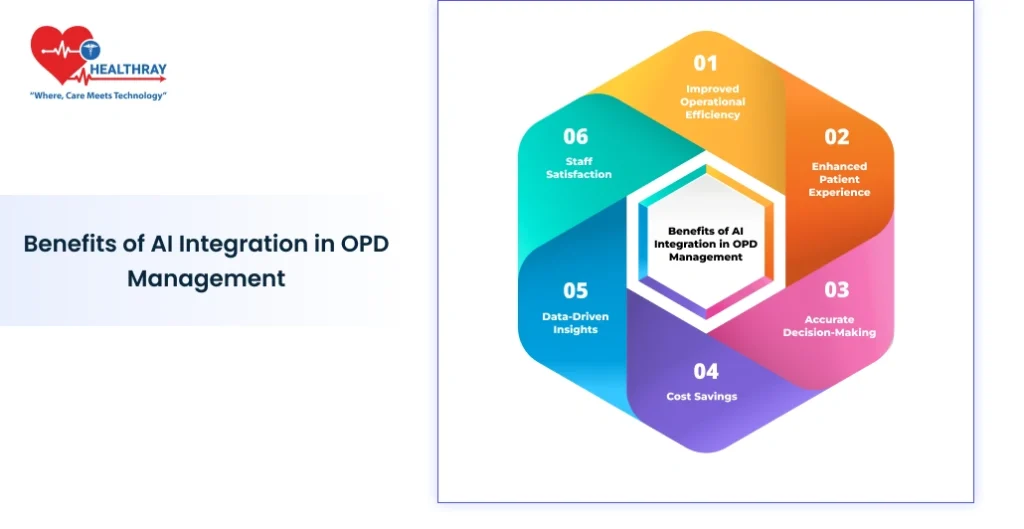
Integrating AI into OPD management software brings transformative changes that go beyond basic automation. From boosting operational efficiency to enhancing patient care, the benefits ripple through every aspect of outpatient management.
Improved Operational Efficiency
- AI reduces manual tasks by automating processes like appointment scheduling, patient check-ins, and billing. This frees up staff to focus on more critical responsibilities.
- Predictive tools help hospitals allocate resources, such as doctors, nurses, and equipment, based on patient flow data.
Enhanced Patient Experience
- Shorter wait times: AI predicts peak hours and adjusts schedules dynamically.
- Personalized care: AI tailors communication and follow-up plans based on individual patient needs, improving satisfaction and outcomes.
Accurate Decision-Making
- Machine learning models analyze vast amounts of patient data to identify trends, potential risks, or treatment pathways. This aids healthcare professionals in making informed, data-backed decisions.
- After gathering information, machine learning does its work and removes missing figures. Vacant places have been filled with other approaches like computing mean and mode. This data assists to create a dashboard reporting for making clearer decisions and predicting for anticipated results.
Cost Savings
- Reduced errors and process redundancies lower administrative and operational costs.
- Optimized resource utilization ensures hospitals spend wisely on staffing and infrastructure.
Data-Driven Insights
- Real-time analytics provide actionable insights into patient flow, treatment outcomes, and department performance. This supports better strategic planning and continuous improvement.
Staff Satisfaction
- By automating repetitive tasks, AI reduces workload stress for hospital staff. This leads to higher job satisfaction and improved staff retention.
Implementation Considerations for AI in OPD Management
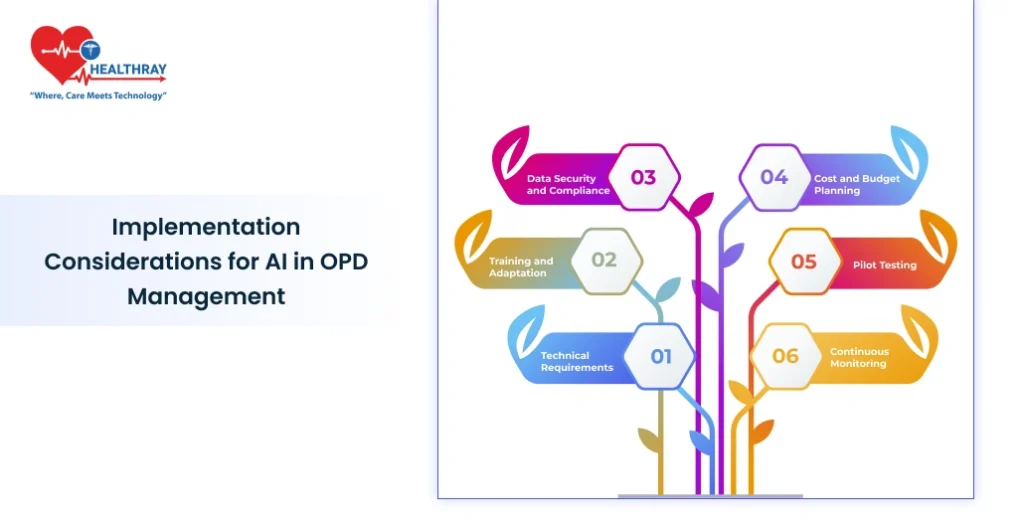
Adopting AI-driven OPD software is a strategic move, but it requires careful planning and execution. Successful implementation depends on addressing technical, operational, and organizational factors.
Technical Requirements
- System Compatibility: Ensure the AI tools can integrate seamlessly with existing hospital management systems (HMS).
- Data Infrastructure: Robust infrastructure is crucial for processing and storing the vast amounts of data AI systems analyze.
- Customization: AI solutions must be adaptable to the specific needs of each hospital, such as patient demographics and workflows.
Training and Adaptation
- Staff Training: Educate hospital staff on using AI tools effectively. Training programs should cover both technical usage and addressing patient queries about AI-driven systems.
- Change Management: Transitioning to AI may face resistance. Clear communication about its benefits can help build trust and acceptance among employees.
Data Security and Compliance
- HIPAA and GDPR Compliance: AI systems must adhere to strict regulations for patient data security and privacy.
- Cybersecurity Measures: Implement advanced encryption, regular audits, and secure authentication methods to protect sensitive data.
- Ethical Usage: Ensure AI decisions, especially in diagnostics or treatment suggestions, are transparent and interpretable.
Cost and Budget Planning
- Initial Investment: AI solutions may involve high upfront costs for software, hardware, and training.
- ROI Assessment: Evaluate the long-term benefits, such as operational savings and improved patient satisfaction, against initial expenses.
Pilot Testing
- Conduct small-scale pilots to test the AI solution’s performance in real-world conditions. This minimizes risks and identifies areas for improvement before full deployment.
Continuous Monitoring
- Regularly assess the performance of AI tools to ensure they meet hospital goals. Updates and improvements based on feedback and analytics keep the system running efficiently.
Challenges and Solutions in AI Integration for OPD Management
Implementing AI in OPD management comes with its own set of challenges. Addressing these hurdles effectively ensures smooth adoption and maximizes the benefits of the technology.
Challenge: Resistance to Change
- Issue: Hospital staff and administrators may resist adopting new AI-driven systems due to fear of complexity or job displacement.
- Solution:
- Organize training sessions to familiarize staff with the healthcare technology.
- Emphasize how AI will assist, not replace, their roles.
- Highlight success stories to build confidence in AI.
Challenge: High Initial Costs
- Issue: AI solutions often require significant upfront investment in software, hardware, and training.
- Solution:
- Start with scalable solutions that can grow with the hospital’s needs.
- Explore government subsidies or partnerships with tech firms offering cost-effective AI solutions.
- Conduct ROI analyses to showcase long-term savings and efficiency gains.
Challenge: Data Privacy Concerns
- Issue: Handling sensitive patient information with AI can raise concerns about data breaches and compliance with regulations like HIPAA and GDPR.
- Solution:
- Implement robust cybersecurity measures, such as encryption and multi-factor authentication.
- Ensure the AI system complies with all relevant healthcare data protection regulations.
- Regularly audit and update security protocols to address evolving threats.
Challenge: Integration with Legacy Systems
- Issue: Older Hospital Information Management System may lack compatibility with modern AI solutions, causing delays and inefficiencies.
- Solution:
- Work with AI providers to customize solutions for existing infrastructure.
- Gradually transition critical functions to AI-driven systems to minimize disruption.
- Use middleware tools to bridge the gap between legacy systems and new technologies.
Challenge: Limited Understanding of AI
- Issue: Many decision-makers may lack knowledge about AI’s potential and limitations, leading to unrealistic expectations or hesitancy in adoption.
- Solution:
- Offer workshops or seminars to educate administrators about AI’s capabilities and practical applications.
- Partner with experienced AI providers to guide the implementation process.
Challenge: Ethical Concerns
- Issue: AI-driven decisions, especially in diagnostics or resource allocation, can raise ethical questions about bias and accountability.
- Solution:
- Use transparent AI models that allow human oversight and explainability.
- Conduct bias audits regularly to ensure fairness in decision-making processes.
- Involve healthcare professionals in AI system design to align it with ethical standards.
Future Trends in AI Integration for OPD Management
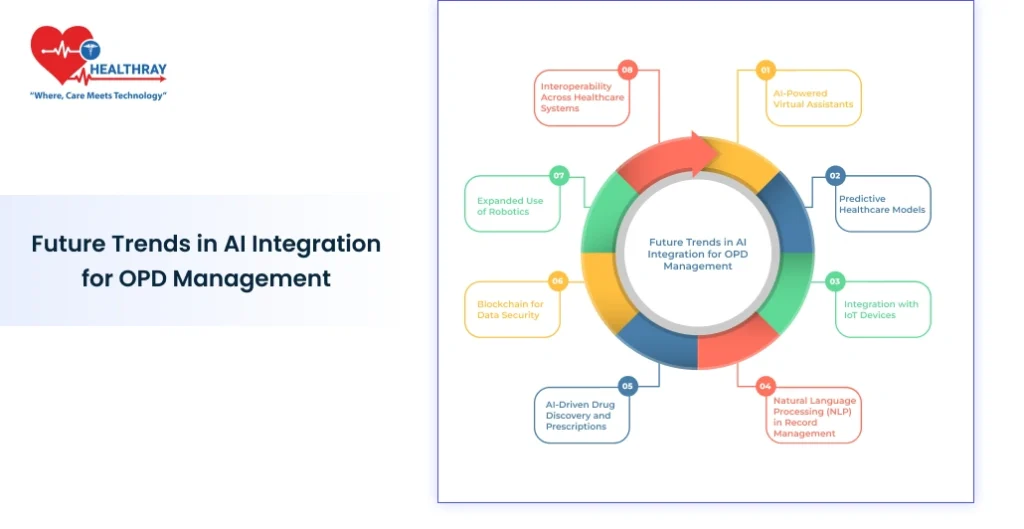
The adoption of AI-powered HMS Software in outpatient management is just the beginning. As the technology evolves, new trends are shaping the future of healthcare, promising even greater efficiency and improved patient outcomes.
AI-Powered Virtual Assistants
- What to Expect: Advanced virtual assistants will handle not just administrative tasks but also basic medical inquiries. They will guide patients through pre-visit procedures, triage symptoms, and suggest next steps.
- Impact: Reduces the workload on hospital staff and enhances patient engagement.
Predictive Healthcare Models
- What to Expect: AI systems will use predictive analytics to anticipate patient needs, such as identifying those at risk of chronic diseases or requiring follow-up care.
- Impact: Preventive care will become a priority, reducing hospital visits and improving long-term patient health.
Integration with IoT Devices
- What to Expect: Wearable devices and IoT-enabled diagnostic tools will sync with OPD management systems to provide real-time health data.
- Impact: Doctors will have continuous access to patient vitals, enabling proactive and personalized treatment plans.
Natural Language Processing (NLP) in Record Management
- What to Expect: NLP technologies will streamline record-keeping by transcribing doctor-patient conversations into accurate, structured data.
- Impact: Simplifies documentation, reduces administrative errors, and saves time for healthcare providers.
AI-Driven Drug Discovery and Prescriptions
- What to Expect: AI systems will analyze patient data to suggest tailored medication options or predict potential drug interactions.
- Impact: Reduces the risk of adverse drug reactions and improves prescription accuracy.
Blockchain for Data Security
- What to Expect: AI and blockchain technologies will work together to secure patient data, ensuring transparency and tamper-proof records.
- Impact: Builds trust in digital healthcare systems by addressing security concerns.
Expanded Use of Robotics
- What to Expect: Robotic systems integrated with AI will assist in outpatient procedures, from diagnostics to minor surgeries.
- Impact: Enhances precision and reduces the strain on medical professionals.
Interoperability Across Healthcare Systems
- What to Expect: AI will bridge gaps between different healthcare platforms, enabling seamless data sharing and collaboration across departments and institutions.
- Impact: Facilitates a unified approach to patient care, improving overall healthcare delivery.
Conclusion
AI integration in OPD management is no longer a futuristic concept; it’s a reality transforming how outpatient care is delivered. From automating administrative tasks to personalizing patient care, the benefits are vast and impactful. For hospital administrators, this means streamlined operations and happier patients. For software developers, it’s an opportunity to innovate and create solutions that address the most pressing challenges in healthcare.
The future holds even more promise. With trends like virtual assistants, predictive analytics, and IoT integration, AI is set to revolutionize outpatient departments further. However, successful adoption requires careful planning, addressing challenges like data privacy, cost, and staff training.
